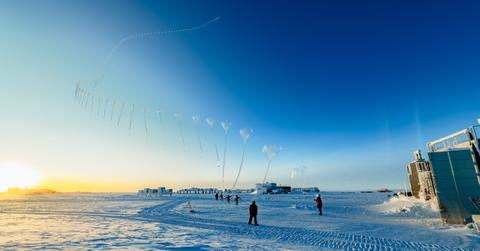The Ozone Hole Over Antarctica May Be Shrinking — Is This a Good Sign?
Published Oct. 28 2022, 11:35 a.m. ET

A NOAA ozonesonde — an instrument used to help scientists monitor the Antarctic ozone hole — ascends over the South Pole in this time-lapse photo taken Oct. 21, 2020.
Different parts of the world are being slammed with a wide range of life-threatening weather conditions — some regions are flooding, while others are suffering from an ongoing drought. But nonetheless climate scientists were recently given a glimmer of hope. The hole in the ozone layer above Antartica, which is letting in ultraviolet rays and is contributing to rising global temperatures, is reportedly getting smaller.
Said hole is currently measuring in at at about .08 million square miles less than it did last year. And since the hole peaked in 2006, it's gotten significantly smaller.
“Over time, steady progress is being made and the hole is getting smaller,” Paul Newman, chief scientist for Earth Sciences at NASA’s Goddard Space Flight Center stated, as per NOAA.
“We see some wavering as weather changes and other factors make the numbers wiggle slightly from day to day and week to week," he continued. "But overall, we see it decreasing through the last two decades. Eliminating ozone-depleting substances through the Montreal Protocol is shrinking the hole.”
The ozone hole may fully heal by 2050.
In many of our lifetimes, the ozone hole may soon be no longer.
Only a few decades after climate change gained notoriety in the 1980s, NASA released data on Oct. 26 that shows the ozone layer may be healing itself, specifically above the Antarctic. The hole has been shrinking over the last several years and is even smaller than it was last year. Scientists are attributing this to smarter consumerism, political intervention, investments to phase out CFCs, and the Montreal protocol.
According to Vox, the hole could completely disappear by the year 2050, based on the rate that it's shrinking. This comes as a huge relief, because at the rate the hole started forming in the 80s, it looked like the hole could end life as we know it.
“Projections suggested that the ozone layer would collapse by 2050,” the Future of Life Institute’s Georgiana Gilgallon stated via Vox. “We’d have collapsing ecosystems, agriculture, genetic defects.”
The formation of the ozone hole above Antartica is an annual occurrence. It forms every September just above the South Pole, according to NASA. Chlorine and bromine molecules then attach themselves to polar clouds, and they effectively shatter the ozone as the suns begins to rise towards the end of Antartica's winter.
Proton auroras, however, are also blasting holes in the ozone layer.
After CFCs were phased out worldwide, HFCs and greenhouse gas emissions continued to deplete the ozone layer. And while human activity is generally the culprit, it turns out proton auroras are also tearing holes in the diminishing protective layer of the atmosphere.
Recently, an aurora was discovered to have blasted a 250-mile wide hole in the ozone layer.
This aurora is different from the Northern Lights, though it is visible from Earth. And while its negative impact on the ozone layer isn't great, it's certainly brightening our day that our annual Antarctic hole may be diminishing, for good.